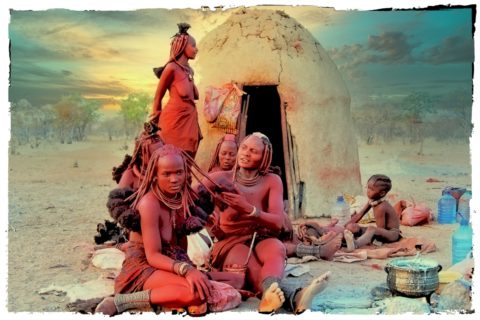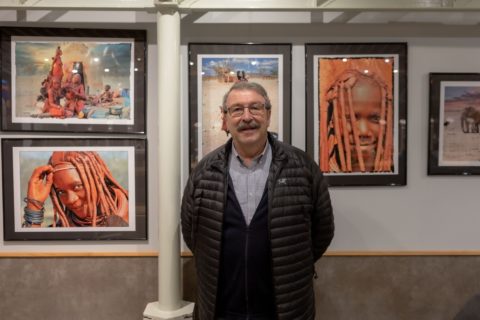“Namibia: White Elephants and Red Women” is the title of the photography exhibition by Alberto Usó from Castellón that can be seen at Las Cervezas del Mercado by BWK in the Mercado de Colón and that captures the life of the women of the Himba tribe, well known for the great beauty and the famous hairstyles. They live in the desert trying to maintain their traditions and share space with white elephants. With this exhibition Usó, who has travelled for 45 years a couple of times a year to various countries and portrayed countless tribes, proves once again that he is faithful to the maxim of the photojournalist Steve McCurry: “If you know how to wait, people will forget about your camera and then their soul will come out”.
Anyone who has met the Himba tribe knows that the visit is arranged with the chief of the village who is given gifts such as flour, tea, sugar or sweets for the children. The chiefs sit in a semicircle under an acacia tree, talk to the visitors, a handshake, “moro” and a few photographs seal the agreement and they authorise the visit to the village, to enter the huts and photograph the women and children. The Himba women start the day by “cleansing” themselves with the smoke from the embers of the evening bonfire. They dress up with calfskin necklaces, bracelets and a calfskin belt. Then they smear their entire black-skinned bodies with a reddish powder obtained by crushing ochre stones and mixing it with cow’s lard and aromatic herbs. For the Himba, the red glow of the women’s skin symbolises their bond with the cattle, one of the pillars of their beliefs. The dowry for marriage consists of 5 goats for the bride’s mother and 10 cows for the father, 5 of which are for the village chief.

Alberto Usó, a member of the Nómadas Click collective, was born in Castellón in 1950 and since his youth he has not stopped travelling with his camera, his indispensable travelling companion. After so many adventures and so many journeys, he has been gathering the essence of the places and their people, some untamed, others dangerous, but all of them very interesting for the numerous photographic exhibitions he has held.

One of the many exhibitions also took place in Las Cervezas del Mercado and reflected the views of women from Namibia, Niger, Algeria, Tanzania, Cambodia, Brazil, Ecuador, Peru, Argentina, Chile, Borneo, Ethiopia and Nepal. He currently has three godchildren in Kathmandu and three in Ethiopia.
Usó has returned to many of the places and has established relationships with some of the tribes, trying to collaborate with them, as for example in the last trip he made in December to the Omo River Valley. With the total amount of money he raised from the sale of an edition of books with his photographs, he was able to buy food, blankets, casseroles, clothes, medicines and even help them build huts.
Between various worlds, Usó still feels that he has to hurry to get to know everything. His motto: “We only have one life, but if we know how to live it, one is enough.”
After photographing the volcanoes of Iceland, it was the turn of La Palma and now he is preparing his fifth trip to Ethiopia, despite the fact that they are at war.
His other visits include Ecuador, Peru, Bolivia, Argentina, Chile, Brazil, Venezuela, Costa Rica, Guatemala, Mexico, the United States, Polynesia, the Seychelles, the Maldives, the Galapagos Islands, Easter Island, Morocco, Algeria, Libya, Libya, Brazil, Venezuela, the United States, the Philippines, the United Kingdom, Morocco, Algeria, Libya, Egypt, Kenya, Tanzania, Namibia, Ethiopia, Java, Borneo, Sri Lanka, Thailand, Nepal, Bhutan, Syria, Jordan, India, Iceland, Cuba, Norway, Sweden, Cambodia, Vietnam, Niger, Burma, Iran and all of Europe.
